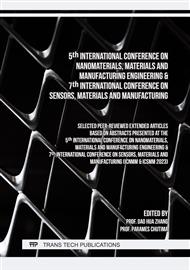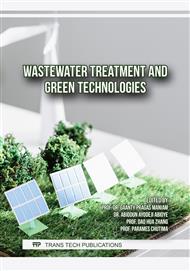p.31
p.39
p.47
p.57
p.63
p.69
p.77
p.83
p.93
Removal of Copper(Cu) from Wastewater Using Modified Recycle Carbon Black (RCB) Waste Tyre
Abstract:
In this century, sustainability has become an essential element in any project to ensure a safe environment. The conversion of waste materials is an important step towards achieving sustainability. Moreover, converting these materials into adsorbents to treat wastewater shows great potential, especially due to its cost-effectiveness and the reduction of solid waste disposal. This research study aims to investigate the removal of Copper (Cu) from wastewater using waste tyre-recycled carbon black (WT-rCB) and modified waste tyre-recycled carbon black (WT-dAC) to determine their adsorption capability. The removal of Copper using WT-rCB and WT-dAC were investigated with various parameters: pH value, adsorbent dosage, and contact time. The chemical-physical activation process was employed to produce the WT-dAC. First, WT-rCB was impregnated with 1:5 wt% of 1 M KOH solution, then physically activated at 650 °C for 1 hr with flowing Nitrogen gas at 1 L/min. The adsorption study observed a removal efficiency of up to 65% using WT-dAC, while WT-rCB showed a removal efficiency of 22% under the optimum conditions. Eventually, the study demonstrates the employability of WT-dAC in the removal of Copper (Cu) from wastewater.
Info:
Periodical:
Pages:
63-68
Citation:
Online since:
February 2024
Price:
Сopyright:
© 2024 Trans Tech Publications Ltd. All Rights Reserved
Share:
Citation:



